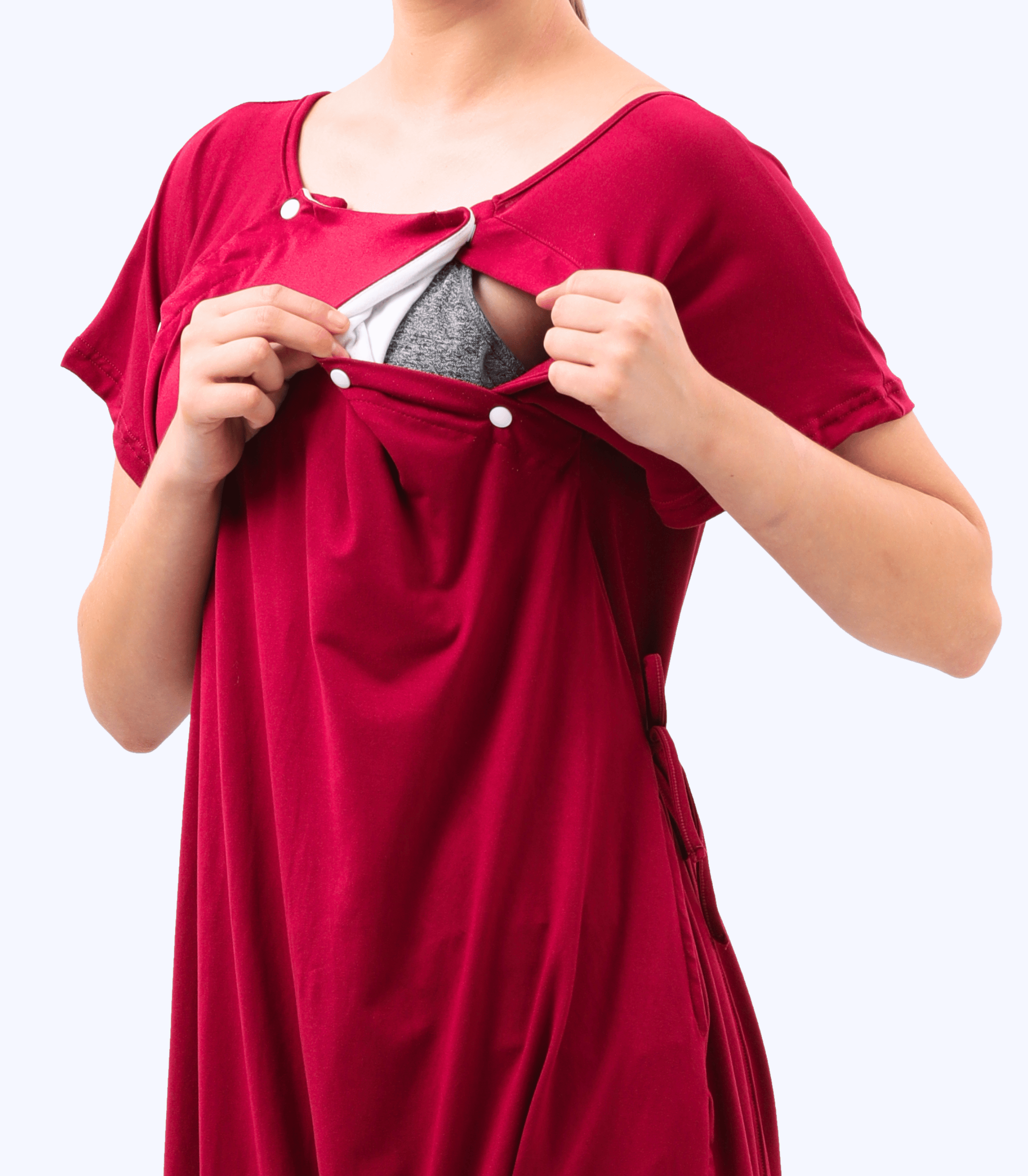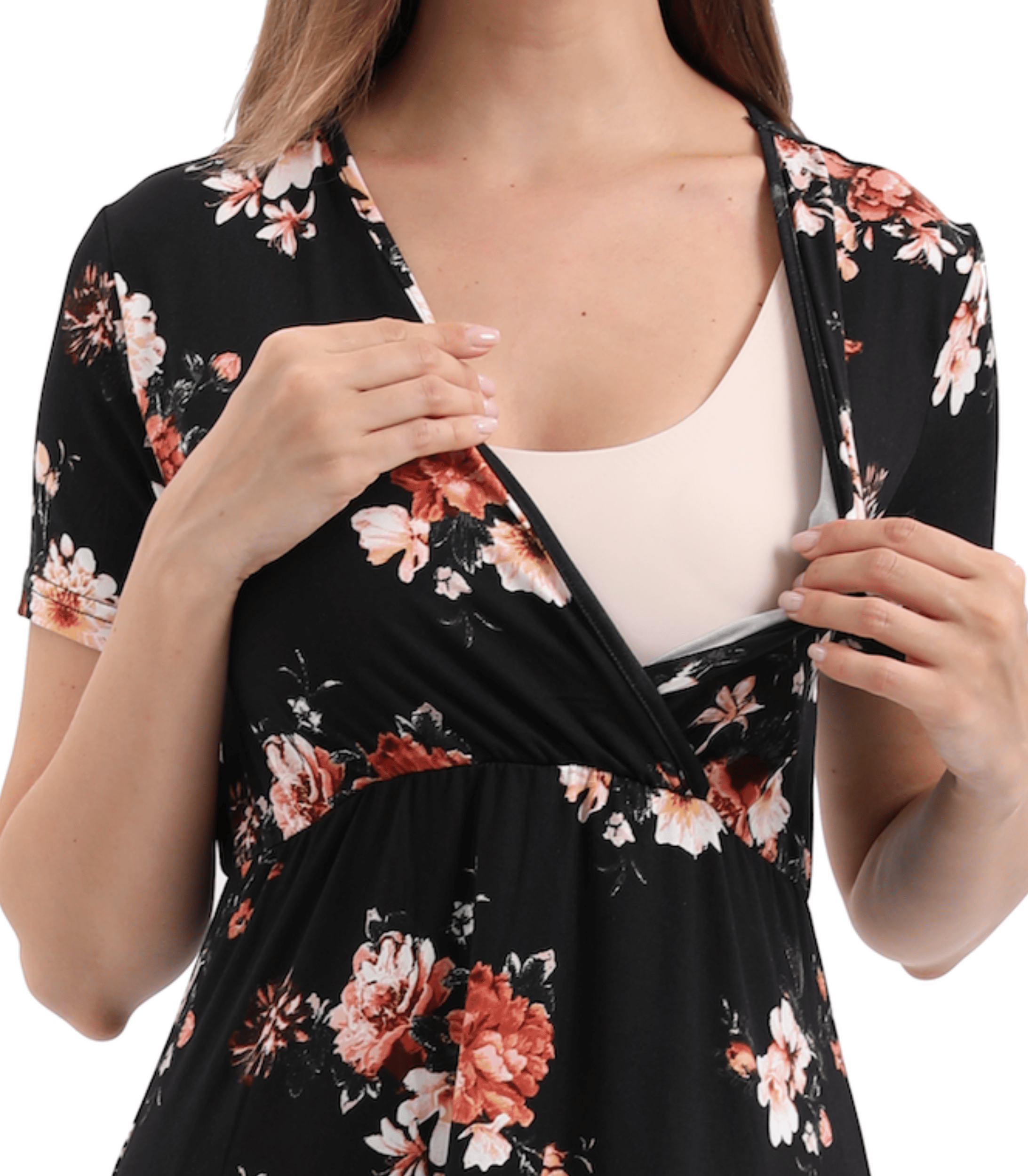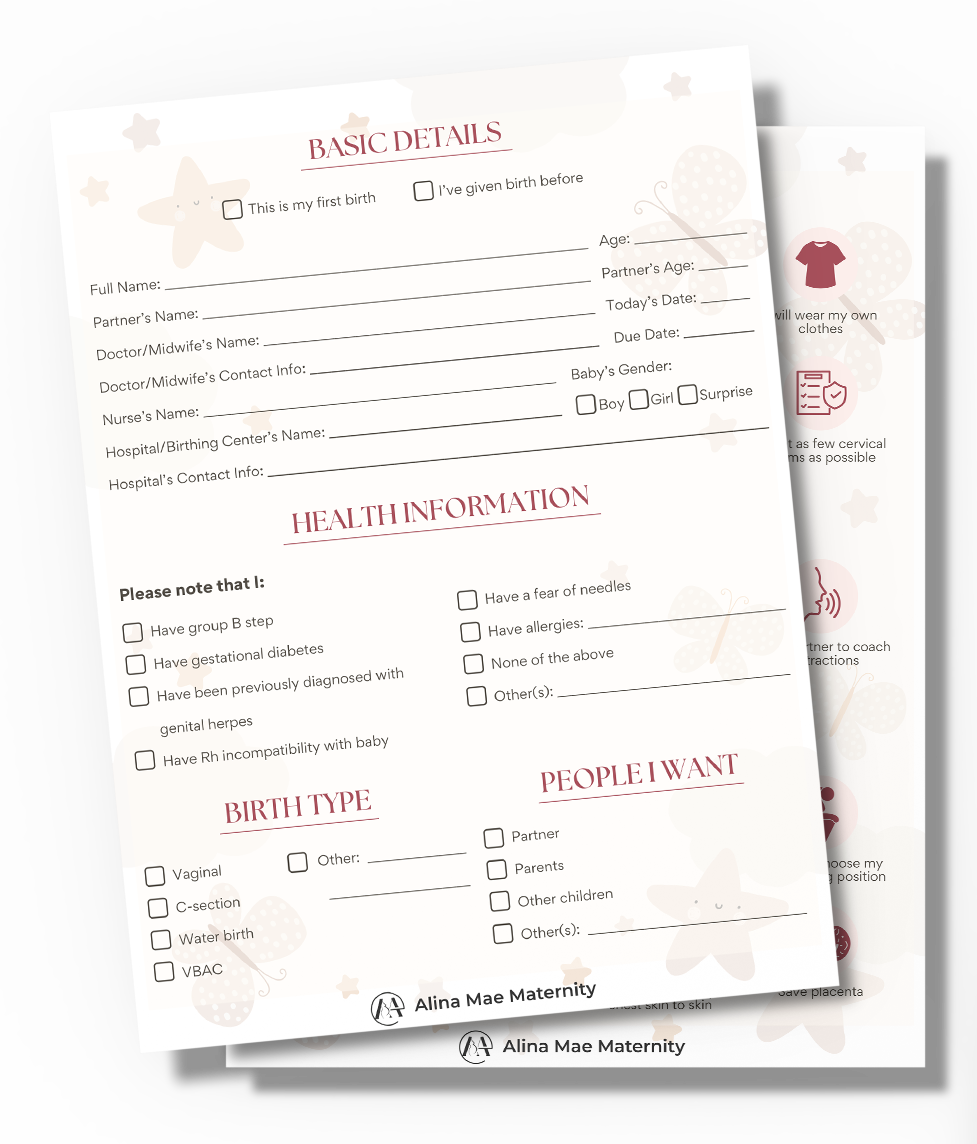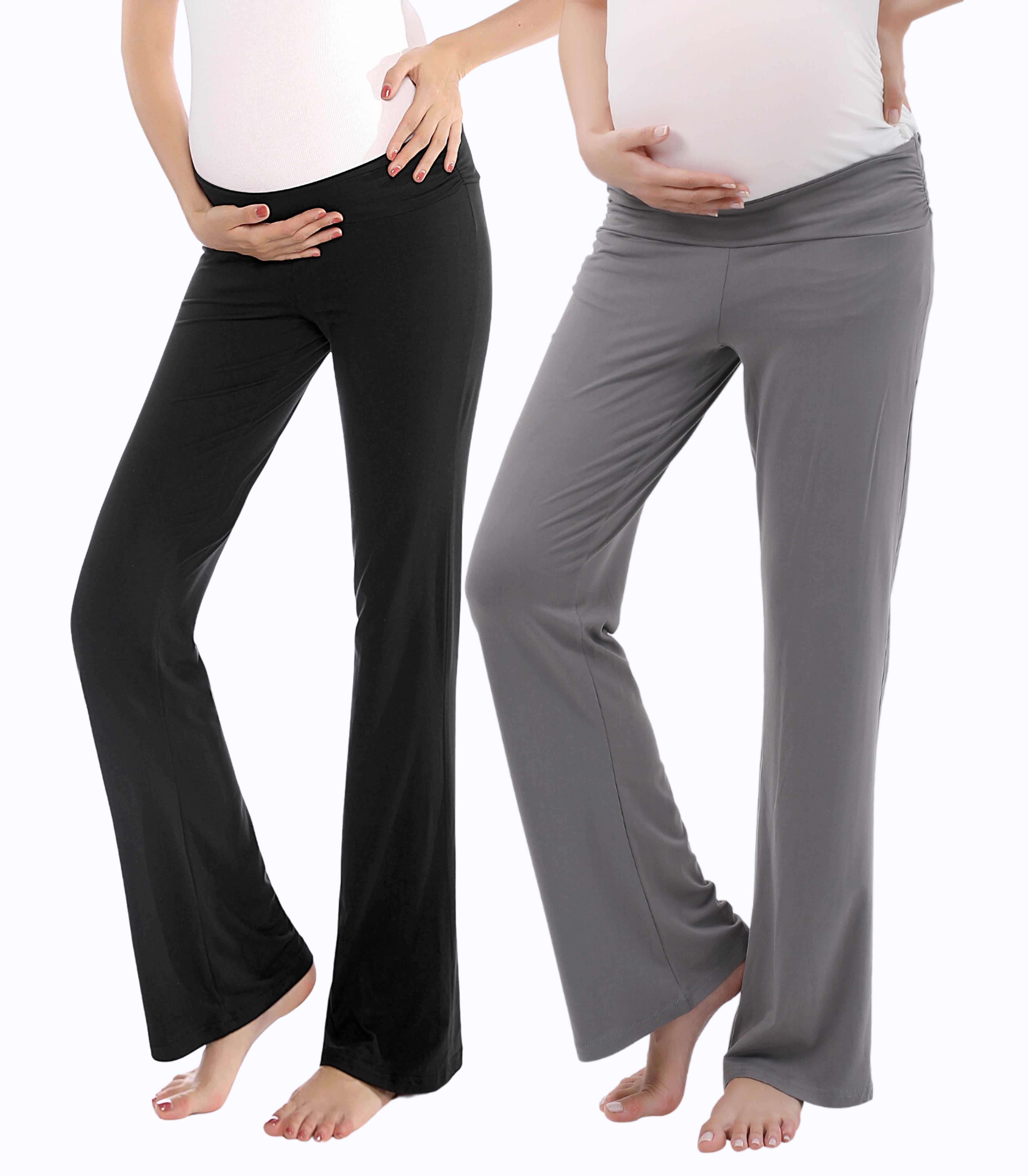How Many Nursing Bras Do I Need?

You’ve probably stocked up on diapers, onesies, and maybe even a white noise machine, but then it hits you: How many nursing bras do I need? Don’t worry, mama. You’re not the only one asking.
Whether it’s your first baby or your third, preparing for breastfeeding can feel a little overwhelming. Between sleep deprivation, cluster feeding, and cozy moments with your newborn, your comfort (and convenience) matter more than ever. That’s where the right number of nursing bras can help, and Alina Mae Maternity is here to guide you through it, one supportive detail at a time.
3 to 5 Nursing Bras for Most Moms
Most moms find that 3 to 5 nursing bras strike the right balance between being prepared and not overbuying. A helpful rule of thumb is to keep one to wear, one to wash, and one as a backup because, let’s be honest, spit-ups and leaks are basically guaranteed for nursing moms.
You may want a couple more nursing bras if you're planning to return to work, pumping frequently, or need extra comfort for nighttime. Choosing a mix of everyday bras, sleep bras, and pumping bras can make those early months of breastfeeding feel smoother and more manageable.
|
Not the Same as a Maternity Bra: Maternity bras and nursing bras are different. Maternity bras are designed for pregnancy, offering stretch and support as your breasts grow and become more sensitive. Nursing bras, on the other hand, are made for breastfeeding and include clip-down or pull-aside cups for easy access. Make sure you’re choosing the right kind of bra for the stage you’re in. |
Factors That Affect How Many Nursing Bras You Will Need
While 3 to 5 nursing bras are a great starting point, every mom’s situation is a little different. What works perfectly for one person might feel like too much or not quite enough for someone else. Your daily routine, how often you do laundry, and even the stage you’re in on your breastfeeding journey can all influence how many nursing bras you’ll need.
Lifestyle & Daily Routine
Your day-to-day life plays a big role in how many nursing bras you'll need. If you're working outside the home, you may want extra bras to rotate between long shifts, business meetings, and pumping breaks. Staying at home or working remotely might mean you're changing less frequently, but you still need soft, supportive options for daily wear and easy nursing access.
Your feeding routine matters, too. Nursing exclusively may require fewer bras than combo feeding or pumping at work. If you're using a breast pump often, you'll likely want a hands-free pumping bra or two in addition to your usual nursing staples as a new mom. Matching your bras to your routine helps you stay prepared no matter what the day (or baby) brings.
Laundry Frequency
Let’s be honest. Babies are messy, and so is breastfeeding. Spit-ups, leaks, and milk stains are just part of the deal. That means how often you can reasonably do laundry will impact how many nursing bras you'll want on hand.
If you do laundry every day or two, three nursing bras might be enough. But if your laundry pile sits a little longer (no judgment here!), having five or more can save you from last-minute stress. It’s all about ensuring you have a clean, dry bra ready when you need it, especially during those unpredictable early weeks after your baby arrives.
Stage of Postpartum
Your nursing bra needs will likely evolve as your postpartum journey unfolds. In the early days, especially during cluster feeding or engorgement, you may go through multiple bras in a day. Soft, stretchy sleep nursing bras are great for around-the-clock comfort in those first few weeks.
Later on, as your feeding routine settles and you return to everyday tasks (or even back to work), your needs might shift toward more structured, durable bras. Having a few go-to styles for hospital bag prep, lounging at home, and professional outfits ensures you're covered wherever you are in your journey.
|
Changing Bra Needs: Breast size, shape, and sensitivity commonly change after pregnancy. That’s why it’s smart to revisit your nursing bra needs regularly. What works during the newborn phase might not be ideal as you return to work, start pumping more, or taper feedings. |
Clothing Choices
What you wear around your nursing bras counts. If your clothes make nursing inconvenient, you might end up switching outfits or bras more often, which adds to your laundry and your need for extra bras.
Nursing-friendly tops and dresses get more use out of your breastfeeding bras without constantly changing. Easy-access clothing means quicker nursing sessions, less tugging and stretching, and fewer outfit changes throughout the day.
Alina Mae Maternity has nursing-friendly clothing designed to make your life easier. Here are some of our standouts:
|
Cloud-Like Soft Hospital Patient Gown |
Floral Hi-Low Maternity Maxi Dress |
 |
 |
|
|
| CHECK PRICE | CHECK PRICE |
Types of Nursing Bras to Consider
Choosing the right mix of nursing bras can make your day smoother, your feedings easier, and your body more comfortable. From sleep-ready softness to hands-free pumping support, the best nursing bras are those that match your needs.They make you feel confident and cared for, every step of the way. Here’s a look at the main types to consider as you build your perfect rotation.
|
Start with the Right Fit: Before choosing your nursing bra lineup, take a moment to measure. The right bra for your breast size isn’t just about comfort. It helps support breast health, prevents issues such as clogged ducts, and makes nursing a whole lot easier. Your body is changing, and the right size makes all the difference. |
Everyday Nursing Bras
These are the daytime bras you’ll wear most of the time. Designed to balance comfort with structure, everyday nursing bras typically feature molded cups or light padding and easy clip-down access for feedings. They offer enough support to wear under work outfits or on errands, without sacrificing the flexibility your body needs.
Look for breathable materials, moisture-wicking fabrics, and stretchy bands to keep you comfortable as your size shifts. Having a few of these in rotation for daytime wear makes daily life and nursing on the go so much easier.
Sleep Bras
Sleep bras are your go-to for around-the-clock comfort, especially in those early days when you're feeding overnight and your body’s still adjusting. They’re made with soft, stretchy fabric and no wires, offering gentle support for your changing shape without digging in or feeling restrictive.
They're perfect for nighttime nursing, lounging, or those moments when you just want to feel held without pressure. For many moms, a sleep bra becomes a favorite, even well beyond the newborn stage.
Pumping Bras
If you’re using a breast pump regularly, a hands-free pumping bra can be a total game-changer. These bras are designed to hold flanges in place so you can pump without using your hands, leaving you free to work, scroll, or sip the coffee you reheated three times. Regular bras simply couldn’t compare.
Some styles combine both pumping and nursing functionality in one, offering serious multitasking power for busy moms. They're especially helpful if you're pumping at work or on a schedule.
Wireless Bras
Wireless nursing bras are ideal for comfort and flexibility, perfect for around-the-house wear, sleep, or early postpartum days when sensitivity is high. They offer light support without pressure.
According to the Mayo Clinic Health System, pressure on the breast can increase the risk of plugged ducts and mastitis:
“This could include pressure from fingers during feedings, tight clothing around or on the breast, underwire bras, or pressure from carrying purse or diaper bag, car seat or baby carrier.”
— Abbey Rose, certified nurse midwife
This is why many lactation consultants recommend opting for well-fitting wireless bras in the early months. They offer the support you need, without the pressure your body doesn’t. And with today’s smart designs, wireless definitely doesn't mean unsupportive. It means breathable, flexible, and mom-approved.
How to Build Your Nursing Bra Lineup
We’ve covered the different types of nursing bras, but how do you turn that info into an actual shopping list? The truth is, you don’t need one of everything. What matters most is finding the right combination for your lifestyle, feeding routine, and overall comfort.
Choosing a variety of bras that support you through sleep, daily wear, and pumping can make breastfeeding feel a lot less overwhelming. Here’s a quick reference table to help you decide what kinds and how many might be right for you.
|
Nursing Bra Type |
How Many to Consider |
When You’ll Use It Most |
|
Everyday Nursing Bra |
2–3 |
Daily wear, errands, nursing on the go |
|
Sleep Bra |
1–2 |
Overnight feeding, lounging at home |
|
Pumping Bra |
1–2 (if pumping regularly) |
Regular pumping sessions, multitasking |
|
Wireless Bra |
2+ (these are great staples) |
Early postpartum, casual comfort |
Many moms find that starting with at least one of each gives them versatility without overpacking their drawer. The goal isn’t to collect every type, but to build a small, useful mix of new bras that keep up with your real life.
There’s No One-Size-Fits-All, and That’s Okay
Every mom’s breastfeeding journey is uniquely her own. Whether you start with three nursing bras or build up to a full rotation, the goal is comfort, convenience, and feeling supported, literally and emotionally. Your needs may shift with your lifestyle, baby’s schedule, or even your laundry habits, and that’s completely normal.
What matters most is finding what works for youand permitting yourself to adjust along the way. Ready to pair those bras with clothing that makes nursing easier? Explore Alina Mae Maternity’s nursing-friendly collection, designed by a mom, for moms, so you can feed, move, and feel amazing every step of the way.















